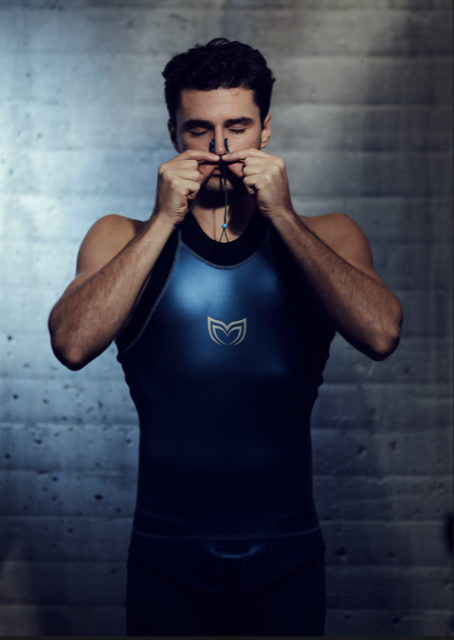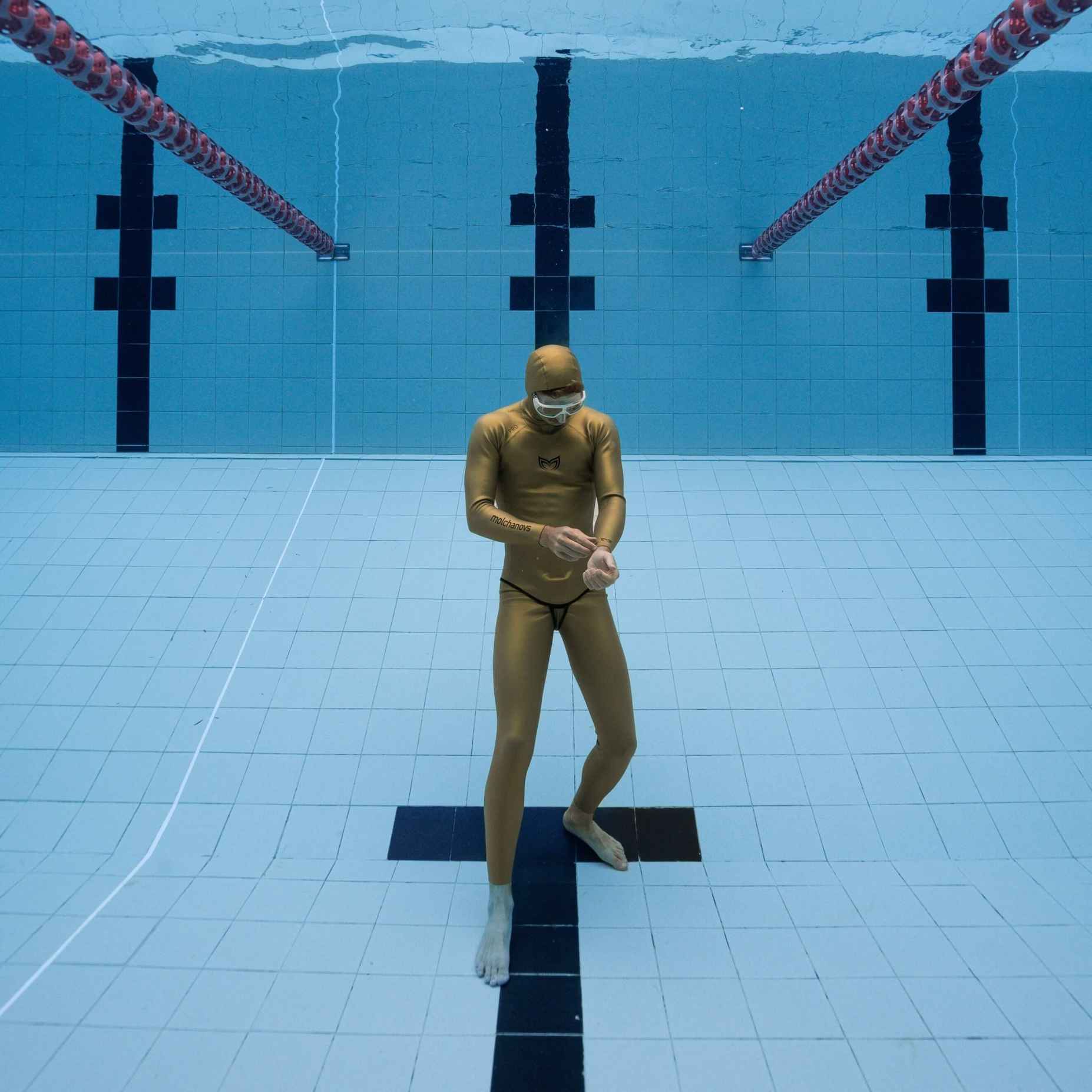What Type of Wetsuit Should I Buy for Freediving?

By Kristina Zvaritch
Contributors: Alexey Molchanov & Alisa Root

The wetsuit you invest in may be one of the most important choices you make for your freediving training. Freedivers require wetsuits to keep from getting cold, for protection against the sun and jellyfish stings, and for better glide in the water. It can be confusing to wade through all of the options and understand which wetsuit fits all of your needs. So the question is, what type of wetsuit should you buy for freediving?
You should buy a freediving-specific wetsuit that is form-fitting, the proper thickness for the water temperatures you are diving in, and suited to the performance you desire out of it. There are many options to choose from when searching for a suitable wetsuit for freediving. Continue reading to learn about the different options below.
Types of Wetsuits
Rash Guard or Lycra Suit
If you are diving in tropical waters, you may see people diving in a rash guard or Lycra suit. While these suits are easier to put on and remove, they do not offer any thermal insulation and may not protect against jellyfish stings or scratches from rocks and coral. Rash guards and Lycra suits can be considered if you are diving solely in the tropics and are diving more for leisure than for training.
Scuba Wetsuits
Scuba wetsuits can offer some inexpensive options and adequate thermal insulation, but have a few drawbacks if they are being used for freediving. Generally, scuba wetsuits use more dense neoprene in order to resist compression at depth, along with stiffer nylon to protect against general wear-and-tear. Unfortunately, this means that the material is less flexible and can hinder the movements of a freediver. Scuba wetsuits also have zippers, which allow water to seep in, and can be very uncomfortable when diving in colder water.
Surf Suits
Wetsuits designed for surfing offer more flexibility than scuba wetsuits, but are often an expensive option. Surf suits are designed to be more buoyant and do not withstand much compression, resulting in quicker compression over time than any other type of wetsuit. They often come with zippers, presenting the same problem for freedivers as scuba wetsuits, and often have extra padding in the chest and abdominal area, which can be restrictive when you take a full breath.
One-Piece Freediving Wetsuits
While one-piece freediving wetsuits are designed specifically for freediving and allow for more movement and flexibility, they also usually come with zippers, allowing water to enter. This type of suit may be easier for beginners to put on and take off, and a few professional freedivers even favor this suit. However, professional freedivers often wear their wetsuits one or two sizes too small, making water leaking through the zipper irrelevant. This also results in a severe decrease in the life of a wetsuit since it is stretched so tight, putting a great deal of tension on the seams.
Contact us for a custom-made one-piece freediving wetsuit.
Two-Piece Freediving Wetsuits

Alisa Root by @alfredminnaarphotography
Two-piece freediving wetsuits are specifically for freediving and come with farmer john-style pants (typically for spearfishing) and a separate top, or high-waisted pants (generally for freediving) and a separate top. Molchanovs pool wetsuits also have the option for low-waisted pants, avoiding additional buoyancy around the belly. Two-piece freediving wetsuits are also useful as you have the option to just wear the top if you feel overheated. They also generally come with a hood, which stops water from entering through the collar area, and need no zippers to fasten, which allows for more freedom of movement.
Contact us for a custom-made two-piece freediving wetsuit.

Alexey Molchanov, Ice Diving World Record
Freediving Wetsuit Materials
The thermal conductivity of water is about 25 times higher than that of air, so even in the warmest water, we will eventually get cold. Neoprene is very flexible and does an excellent job of slowing down heat loss. The drawback is that neoprene is very sensitive to sun exposure, scrapes, and tears.
Double-Lining
Double-lining indicates lining on both the inside and outside of the wetsuit, with neoprene in-between.
Advantages:
Double-lining makes the wetsuit incredibly durable, helps with stretch resistance, and is easy to put on and remove, which is a great option for beginners.
Disadvantages:
Lining on the inside does not adhere to the skin and allows water to move in and out of the suit, which can cause the freediver to become colder quicker. This does not have to be a disadvantage if the wetsuit is very form-fitting and adheres well to your body.
Look out for our double-lined CORE Training wetsuit, available in the near future, or contact us for a custom-made double-lined freediving wetsuit.
Single-Lining
Single-lining means that there is lining either on the inside or outside part of the wetsuit. This type of wetsuit is less durable than double-lined wetsuits, but still quite durable nonetheless as it protects the neoprene from over-stretching.
Single-Lining Outside (Open Cell)
Suits with lining on the outside are often referred to as open cell wetsuits, meaning that the unlined side has exposed open neoprene cells. This is a popular option among recreational freedivers.
Advantages:
Open cell wetsuits slow down heat loss considerably as the neoprene sticks directly to your skin, significantly reducing the amount of water flowing in and out of the wetsuit. The lining on the outside makes the suit more durable and gives a bit of protection against accidental scrapes against objects. The lining on the outside also makes the wetsuit more flexible than wetsuits with double-lining.
Disadvantages:
It can be difficult to put on and remove open cell wetsuits as the neoprene is very sticky. Putting the wetsuit on in water is an easy option, but if you have to wear it on land, you can use eco-friendly soap or conditioner mixed with water, or even baby powder, to lubricate the suit before sliding into it. If you use normal body soap or conditioner, make sure to thoroughly rinse the inside of the wetsuit after you have put it on and before stepping into the water to avoid exposing the ocean to harsh chemicals. The open cell material on the inside is prone to tears from nails, so extra care must be taken when putting on and removing the wetsuit.
Check out our Molchanovs Men’s and Women’s SPORT Wetsuits for an ideal freediving training wetsuit.
Single-Lining Inside (Smooth Skin Outside)
Suits with lining on the inside are often referred to as smooth skin wetsuits, which describe the outside of the wetsuit. The open cells of the neoprene on the outside of the suit are smoothed over and closed with a special treatment, leaving the surface very hydrodynamic.

Arnaud Jerald by Antonin Grenier
Advantages:
Smooth skin wetsuits are the preferred choice among freediving athletes. Different lining types are used for different sports, but freediving-specific lining is much more flexible. The smooth skin makes the suit very hydrodynamic and helps the freediver glide more easily through the water. The lining on the inside makes it easier to put on and remove the wetsuit. Some freedivers also prefer smooth skin wetsuits for the wide variety of colors that are available.
Disadvantages:
Smooth skin is very delicate, and is vulnerable to tears from nails or scrapes from the outside environment. The sun’s rays are also damaging to smooth skin, and the suit will begin to crack after time. This wetsuit should only be considered if performance is your primary focus.
No Lining (Smooth Skin Open Cell Wetsuit)
A wetsuit with no lining; smooth skin on the outside and open cell on the inside, often called a smooth skin open cell wetsuit.
Advantages:
Wetsuits with no lining will have maximized glide and hydrodynamic properties along with maximum thermal insulation.
Disadvantages:
Wetsuits with no lining are extremely fragile. They require soap or baby powder to put on and remove and are highly vulnerable to tears and scrapes. These types of wetsuits are more durable if they are 5mm or thicker.
Check out our Molchanovs Men’s and Women’s PRO Wetsuits, both available in hoodless or sleeveless variants, as a competition-specific freediving wetsuit.
Sandwich
A sandwich wetsuit is fairly uncommon among freedivers due to its disadvantages. It involves a layer of elastic nylon sandwiched between open cell on the inside and smooth skin on the outside.
Advantages:
A sandwich wetsuit is more durable than a wetsuit with no lining, and increases stretch resistance. These wetsuits offer maximized glide and minimum heat loss, equivalent to wetsuits with no lining.
Disadvantages:
Sandwich wetsuits are less stretchy than wetsuits with no lining due to a heavy use of glue, which adds stiffness. They are also very susceptible to tears and scrapes.
One-Piece Freediving Wetsuits
One-piece freediving wetsuits are similar in looks to scuba wetsuits, but use a different type of neoprene and include a cut that seals more efficiently at the collar and allows more flexibility and movement. They are typically lined on the inside with smooth skin on the outside. These types of wetsuits are more common in pool disciplines for professionals as they are thinner (1-2mm), have less need for thermal insulation, and have more glide due to the smooth skin.
Advantages:
These wetsuits are very hydrodynamic with less buoyancy due to their thinness and lack of a hood. There is also less neoprene than the traditional two-piece freediving wetsuit due to the absence of an overlap of the wetsuit top and pants.
Disadvantages:
The lack of a hood decreases thermal insulation, along with the thinner neoprene and the possibility of water entering at the collar area. These types of wetsuits also require a zipper, which can allow water to seep in.

Mikey by @pow.finns
Wetsuits and Water Temperature
Heat loss is inevitable in water, but wearing a wetsuit makes heat loss slower. If you are not sure which thickness of wetsuit to get based on water temperature, here are general recommendations based on a one-hour freediving session, although it may vary from person to person.
28°C and warmer: 1-1.5mm
24-28°C: 3mm
18-24°C: 5mm
16-17°C and colder: 7mm
It is important to get the thinnest possible wetsuit while still ensuring enough thermal insulation. Thicker wetsuits come with heavier weights, which means that you will be more negative at depth due to neoprene compression compared to a thinner wetsuit with less weights.
Socks and gloves are critical when diving in colder waters, as the hands and feet get cold first. Socks and gloves are usually double-lined or have open cell inside and Lycra outside, but experienced freedivers may opt for smooth skin on the outside.
Look out for our Molchanovs double-lined CORE and open cell SPORT gloves and socks, available in the near future.
Standard Sizes or Custom-Fit Wetsuits
If you are of typical proportions and are using your wetsuit purely for recreational freediving, a standard-sized wetsuit may be an option for you. Make sure to try the wetsuit on before buying if possible, or check the measurements on the manufacturer’s website and measure yourself with only a bathing suit on. If you are between sizes, consider investing in a custom-fit wetsuit, especially for 5-7mm wetsuits.
If you are not of typical proportions or just desire a well-fitting wetsuit, opt for a custom-fit wetsuit. Have someone take your measurements as directed by the manufacturer and double-check them afterwards. Some custom add-ons targeted towards spearfishers may be available, such as reinforced knees, reinforced elbows, knife pockets, and loading pads for spearguns.
Check out our Molchanovs Custom Performance Wetsuits.
 Vitomir Maričić
Vitomir Maričić
Wetsuit Care
Be sure to put on and take off your wetsuit very carefully, rinse it in fresh water after diving, and store it in a cool, dry place. Hang the wetsuit carefully and avoid prolonged exposure in direct sunlight for extended periods of time. You can gently hand-wash your wetsuit with laundry detergent periodically.Do not let the overabundance of information confuse you when buying a wetsuit. Once you know the thickness required for the water you are diving in, the type of wetsuit that is best-suited for your needs, and the type of fit you desire, the abundance of options are greatly reduced, allowing you to make a simpler, more-informed decision.





Leave a comment